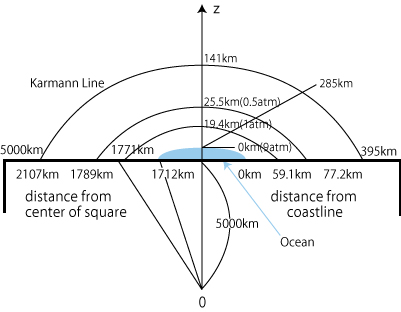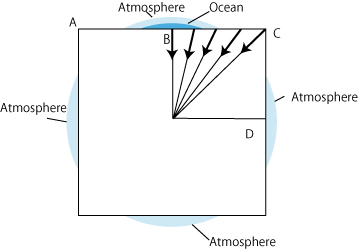Atmosphere and Ocean are Formed like a Convex Lens

As described in Part 1, the atmosphere covers the central part of a square surface of the cubic Earth in a form of a convex lens. If there are both atmosphere and ocean on the same square, the atmosphere is piled on the surface of the ocean, because the density of the ocean is greater than that of the atmosphere, i.e., the atmosphere covers the ocean in the form of a convex lens at the center of the square. Fig. 1 shows the vertical cross section of these configurations. Note that the atmospheric pressure at the surface of the ocean is constant. The value is 9 atm. This means that the surface pressure of the cubic Earth is 9 times greater than that of the real Earth. This is caused by a fact that the atmosphere is concentrated at the center of the square of the cubic Earth. On the other hand, on the real Earth the atmosphere occupies the whole surface of the Earth.
You Feel the Ground Inclined
The coastlines are located at 1700 km from the center of the square. The atmospheric pressure decreases toward inland as if the pressure decreases with altitudes in mountaineering in the real Earth. The decrease of the atmospheric pressure in inland is caused by the direction of gravity which directs at the center of the cubic Earth as shown in Fig. 2. At the edge of the squire the gravity makes an angle of 45degrees for the surface. If you stand at the edge of the cubic Earth, you will feel as if you are at the top of the steep mountain.


If you walk from A to D through B and C, you will feel as if you walk on a inclined surface shown in Fig. 3. You will realize that the cubic Earth consists of almost sloping lands. The inclination at the coastline is 18.9 degrees. The inclination of the land at 1 atm and 0.5 atm are 19.5 degrees and 19.7 degrees, respectively. The habitable zone where the atmospheric pressure is between 0.5 atm and 1 atm is located on the land with inclination of about 19 degrees. Fig.4 shows the derivation of these figures.



